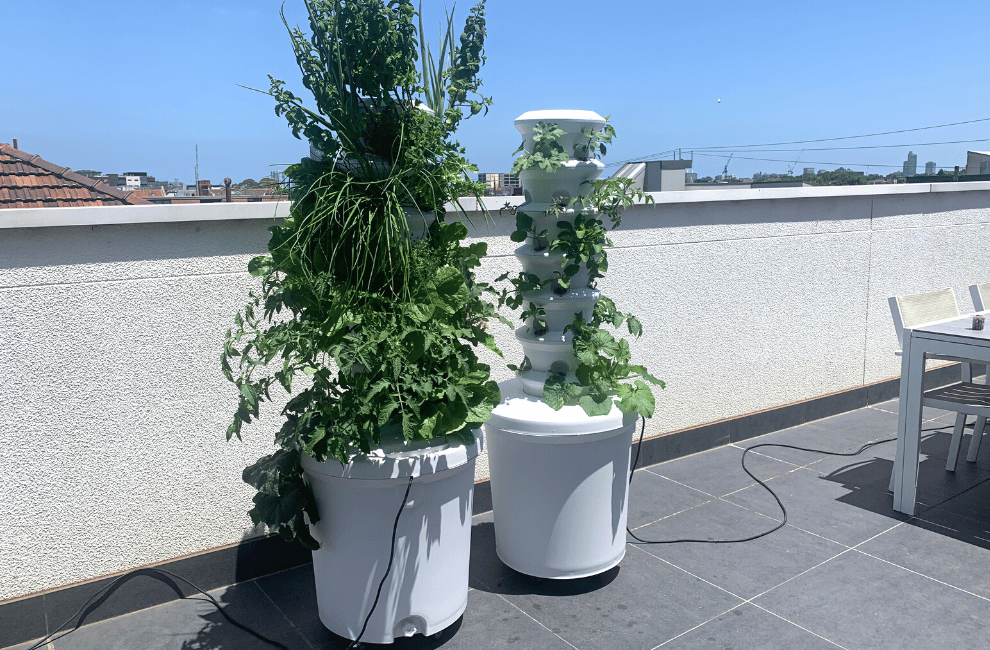
What is Aeroponics?

Aeroponics is an advanced type of hydroponics, where plants are grown without the use of any soil. Plants are instead grown by delivering water and nutrients directly to their roots – giving them all the necessary elements they need to thrive in a controlled agricultural environment. Unlike other forms of hydroponics, with aeroponics plant roots are suspended in open air and periodically delivered nutrient-rich water via a spray, mist or droplets.
As plants thrive with increased oxygenation, aeroponics typically allows for faster plant growth, higher yields, and lower water usage compared to traditional soil-based growing.
What does aeroponics mean?
The term aeroponics stems from the Greek words for air, “aer,” and labor, “ponos”, literally translating to “working air”, and started to gain popularity in the 1990’s when NASA started utilising the technology to grow fresh food in space.
Whilst there are several types of hydroponic systems that are used to grow plants without soil, aeroponics is the only method where plants do not require a growing medium, allowing roots to hang in open air in a closed environment with the goal of helping them grow faster and healthier.
How does aeroponics work?
With aeroponics, plants can be grown either vertically or horizontally. Plants are held in place with a light medium such as coco-coir, clay balls or foam rings, with the top and crown of the plant growing outside, and the roots hanging freely in open air internally.
Natural nutrients that emulate those in soil, such as nitrogen, phosphorus, and potassium, are added to a central reservoir along with water. The reservoir solution is ideally kept at a temperature range between 15C - 20C, to maximise the absorption rate of the plant and reduce the risk of bacteria growth.
The nutrient-rich solution is then pumped around the system as mist or droplets in precisely determined intervals, feeding the exposed plant roots with everything they need to grow. The intervals at which plants are watered differs according to various factors such as the type of aeroponics, the season, plants being grown, and time of day.
There are ongoing maintenance tasks which need to be completed when growing with aeroponics, such as measuring and adjusting the pH levels to ensure that enough nutrients are getting absorbed into the plants, and measuring and adjusting the EC levels to ensure the nutrient density of the water-nutrient solution is en point for what is being grown, however all of them are relatively straightforward and achievable for home-growers.
What can you grow with aeroponics?
In terms of what you can grow with aeroponics, theoretically anything! However they are best suited and most commonly used for growing plants like herbs, leafy greens, and vining vegetables (e.g. zucchini, capsicum, tomato and cucumber). Unlike with hydroponics, rooting crops like potato and carrots can also be grown in horizontal systems as the roots have plenty of room to grow, however they have more complex nutrient requirements.
Types of aeroponics
There are two main types of aeroponics: low pressure and high pressure. Low pressure is the most used by home growers since it is low cost and easier to set up, whereas high pressure is the preferred method for commercial production as it is typically more efficient.
High-pressure aeroponics
High-pressure aeroponics uses high-pressure pumps to convert the nutrient solution into a fine mist. The mist is then delivered directly to the roots of the plants through a highly pressurised nozzle.
High-pressure aeroponic systems require a pressurised reservoir capable of holding 60 to 90 psi, along with commercial-quality nozzles that can create a fine enough mist. The fine mist created with high-pressure aeroponics provides more oxygen to plant roots, allowing them to absorb the nutrients quickly and efficiently.
Low-pressure aeroponics
Low-pressure aeroponics uses a low-pressure pump to create a gentle mist that is delivered to the roots of the plants. With low-pressure aeroponics the mist is more like a light spray or droplets, and is designed to allow the roots to absorb the nutrients slowly and steadily, providing a more gradual and consistent source of nutrients.
This method of aeroponic growing is often used for delicate and slow-growing plant species that may be damaged by high-pressure mist systems, as well as DIY growers as it is inexpensive to set up.
Advantages and disadvantages of aeroponics
Growing with aeroponics mitigates many of the challenges and environmental implications of modern large-scale agriculture, however it has both advantages and disadvantages.
Advantages of aeroponics
- 3X faster growth: With aeroponics, plants’ roots have higher access to oxygen and humidity than when being grown in soil or other hydroponic systems, resulting in faster growth and bigger yields
- 95% less water: As aeroponic systems are enclosed, the water-nutrient mix is continuously recycled within the system with no run-off or evaporation
- 98% less space: As aeroponic systems can come in both vertical and horizontal forms, they inherently take up less space than traditional farming or gardens
- Year-round production: As aeroponics creates a controlled environment where the grower controls and aspects (e.g. temperature, sunlight, nutrients), and can also be used with indoor growing technology, plants can be grown all year round in all conditions.
- Reduced need for chemicals: The closed, controlled environment eliminates possible contamination and pest issues, so there is no need for herbicides or pesticides
Disadvantages of aeroponics
- Cost: Setting up an aeroponic system can be expensive, as it requires specialised equipment, such as high-pressure pumps and misters.
- Technical difficulty: Aeroponic systems require careful monitoring and adjustment, and any malfunction or technical problem can have a significant impact on the health of the plants.
- Power requirement: Aeroponic systems require a constant source of electricity to power the pumps and misters, making it difficult to use this method in remote or off-grid locations.
- Water quality: The water quality in an aeroponic system must be carefully monitored and maintained to prevent contamination, clogging and other issues that can impact the health of the plants.
Examples of aeroponics
- Vertical aeroponic gardens: This type of aeroponic system is designed to grow plants vertically, in a stacked arrangement, allowing for maximum use of space in a limited area. For example, the Airgarden is a vertical aeroponic garden that allows you to grow 30 plants in just one metre²
- NFT (Nutrient Film Technique) aeroponics: This type of aeroponic system involves circulating a thin film of nutrient-rich solution over the roots of the plants. The film is constantly replenished, providing a continuous supply of nutrients.
- Closed-loop aeroponics: This type of aeroponic system is fully enclosed and recirculates the nutrient solution, reducing water waste and providing a stable, controlled growing environment.
- DIY aeroponic systems: There are many DIY aeroponic systems available that allow individuals to set up their own aeroponic growing system using off-the-shelf components and basic construction skills.
- Commercial aeroponic systems: Commercial aeroponic systems are used by large-scale growers and can be designed to grow a wide variety of crops, including leafy greens, herbs, and small fruits.
Learn more about our airgardens
Aeroponics is increasingly becoming the chosen method for growing produce both commercially and at-home, due to its ability to maximise nutrient absorption, leading to faster growth and produce that is healthier, fresher, higher in nutritional value, and more delicious!
At Airgarden, we provide the #1 vertical aeroponic system purpose built for home growers, and would love to help you get started growing your own fresh, organic, healthy produce. Check out how it works or get in touch with us directly.







